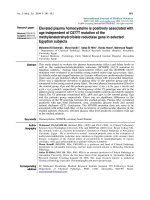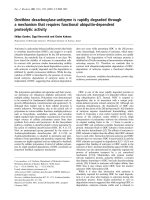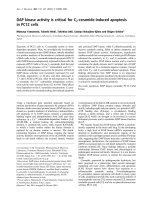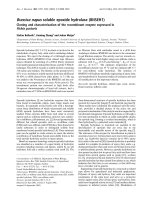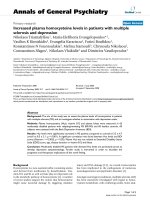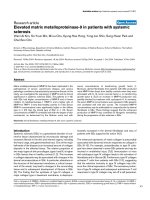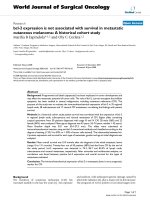Báo cáo y học: "Elevated plasma homocysteine is positively associated with age independent of C677T mutation of the methylenetetrahydrofolate reductase gene in selected Egyptian subjects"
Bạn đang xem bản rút gọn của tài liệu. Xem và tải ngay bản đầy đủ của tài liệu tại đây (755.86 KB, 12 trang )
Int. J. Med. Sci. 2004 1: 181-192
181
International Journal of Medical Sciences
ISSN 1449-1907 www.medsci.org 2004 1(3):181-192
©2004 Ivyspring International Publisher. All rights reserved
Elevated plasma homocysteine is positively associated with
age independent of C677T mutation of the
methylenetetrahydrofolate reductase gene in selected
Egyptian subjects
Research paper
Received: 2004.6.25
Accepted: 2004.9.20
Published:2004.10.12
Mohamed El-Sammak
1
,
Mona Kandil
1
,
Safaa El-Hifni
1
,
Randa Hosni
2
, Mahmoud Ragab
1
1
Departments of Chemical Pathology, Medical Research Institute Hospital, Alexandria
University, Egypt.
2
Internal Medicine
(Cardiology Unit), Medical Research Institute Hospital, Alexandria
University, Egypt.
A
A
b
b
s
s
t
t
r
r
a
a
c
c
t
t
This study aimed to evaluate the plasma homocysteine (tHcy) and folate levels as
well as the methylenetetrahydrofolate reductase (MTHFR) C677T mutation in
Egyptian subjects. Fasting total homocysteine (tHcy) and the (MTHFR) C677T
mutation were evaluated in 50 healthy young control males (age 35-50 years, Gp1),
50 elderly males age ranged between 50-75 years without any cardiovascular diseases
(Gp2) and 50 age matched elderly male patients (Gp3) with myocardial infarction.
There was a significant elevation of plasma tHcy in the patients group and Gp2
compared to the young control group (Gp1). The total plasma homocysteine (tHcy) in
the control group, Gp2 and the patients group were 17.99 ± 9.76, 39.9 ± 20.06 and
43.8 ± 13.13 µmol/L respectively. The frequency of the TT genotype was 12% in the
patient group compared with 8 % in the young healthy controls and elderly subjects
(Gp2). The CT genotype constituted 36%, 48% and 44% in the control group, Gp2
and the patients group respectively. There was no significant difference in the
occurrence of the TT genotype between the studied groups. Plasma tHcy correlated
positively with age, total cholesterol, urea, creatinine, glucose levels and carotid
intimal thickness (CIT). Conclusion: The MTHFR mutation does not seem to be
associated with either high tHcy or the occurrence of cardiovascular diseases in the
studied patients. However, elevated plasma tHcy level positively correlates with age
in the studied subjects.
K
K
e
e
y
y
w
w
o
o
r
r
d
d
s
s
Homocysteine, MTHFR, coronary heart disease
A
A
u
u
t
t
h
h
o
o
r
r
b
b
i
i
o
o
g
g
r
r
a
a
p
p
h
h
y
y
Mohamed EL-SAMMAK obtained MSc (1998) and Ph.D (2001) in Clinical Laboratory
Sciences from Nottingham University, UK, and MRCPath (2003) from Royal College UK.
He currently works as a lecturer & honorary Consultant in Clinical Pathology at Alexandria
University, Egypt. He is involved in several research projects such as the evaluation of
methylenetetrahdrofolate reductase gene mutation in Egyptian patients with coronary heart
disease; evaluation of the clinical utility of procalcitonin in tonsilopharingitis of various
etiologies; ACE gene polymorphism in patients with pre-eclampsia.
Mona Kandil (MBCHB, MSc, PhD,MD) is a professor and head of Clinical Pathology
department in Alexandria University, and her main research interest is Molecular Chemical
Pathology.
Safaa El-Hifni (MBCHB, MSc, PhD, MD) is an emirates professor in Clinical Pathology at
Alexandria University where she has been head of the department in Alexandria Medical
Research Institute Teaching hospital till 2001. Her main research interest is analytical
Chemical Pathology especially Chromatography and mass spectroscopy.
C
C
o
o
r
r
r
r
e
e
s
s
p
p
o
o
n
n
d
d
i
i
n
n
g
g
a
a
d
d
d
d
r
r
e
e
s
s
s
s
Dr Mohamed Elsammak, Medical Research Institute hospital, 165 El-Horreya Street,
Department of Chemical Pathology. POB: 21561 Alexandria, EGYPT. Email:
Int. J. Med. Sci. 2004 1: 181-192
182
1. Introduction
Homocysteine lies at an important metabolic branch point of methionine metabolism, between the
remethylation and transsulfuration pathways [1]. These lead to the formation of methionine and
cystathionine, respectively [2,3]. Several enzymes regulate these pathways under normal conditions [4-
6]. Methionine formation is tightly tied to a vitamin B12-dependent enzyme [4,7,8] methionine
synthase, which uses 5-methyltetrahydrofolate as a carbon donor [6] . This donor is synthesized by the
methylenetetrahydrofolate reductase (MTHFR) gene from 5,10-methylene-tetrahydrofolate [9,10].
Reduction in the activity of these enzymes caused by congenital defects and/or deficiencies in folate
may affect the normal homocysteine pathway [9, 11].
A relationship between hyperhomocystinemia and cardiovascular disease is well established [12-
15]. A thermolabile variant of MTHFR, with reduced specific activity has been described [16]. Frosst et
al [17] identified that a substitution of cytosine (C) by thymine (T) at nucleotide 677 of the MTHFR
gene that converts an alanine to a valine residue was responsible for the thermolability of MTHFR.
Actually, the frequency of the mutated allele was quite high, depending on the ethnic group analyzed
[18-21]. Some authors suggested that the homozygosity for the MTHFR C677T polymorphism was
associated with an increased risk of coronary heart disease [9,22] whereas others failed to demonstrate
this association [23-25]. Furthermore, a recent meta-analysis study pointed at a moderate increase in
plasma homocysteine and the risk of CVD in patients with MTHFR mutation [26].
The tHcy level is strongly dependent on the folate and vitamin B12 status of each individual
[27,11,28]. Plasma tHcy may be increased in cases of severe, folate deficiency [8] and folate
supplements reduce plasma tHcy levels [29]. The response to folate supplements is affected by the
number of the 677T alleles in the MTHFR gene, with the strongest response in 677T homozygotes [30].
On the other hand, the association between carotid and coronary artery disease is well recognized [31]
and ultrasonography of the carotid arteries with measurement of the carotid intimal thickness (CIT) had
been shown to correlate with the severity of atherosclerosis [31]. Some studies showed a strong
correlation between elevated plasma homocysteine, MTHFR mutation and CIT [32,33] while others
gave equivocal results [34,35].
No data are available about the frequency of the MTHFR mutation and its relation to tHcy in the
Egyptian population. Thus the aim of the present study was to determine tHcy level and its relationship
to MTHFR C677T polymorphism in patients with established coronary heart disease, age and sex
matched elderly subjects and in healthy young controls.
2. Material and methods
Subjects
The current study was carried on three groups. A control group
(n=50) consisted of healthy young
male volunteers, their age ranged between 35-50 years (Gp1). Another group of healthy elderly subjects
not complaining of any cardiovascular disease their age ranged between 50-75 years (Gp2). The
patients group (Gp3) consisted of a total of 50 unrelated male patients with past history of myocardial
infarction (age ranged between 50-75 years). All patients and controls were living in the same
geographic area of Northern Egypt (Alexandria), all of them had the same life style (non of them was
heavy smoker, had excessive alcohol consumption or special dietary habit). The exclusion
criteria for all
groups were as follows: vitamins supplementation (e.g. betaine,
choline, folate, vitamin B
6
, or vitamin
B
12)
, the presence of any
form of cancer, liver disease, primary renal disease or any collagenic diseases.
All subjects gave informed consent before the study began. Patients who had history of myocardial
infarction (confirmed by ECG findings and elevated troponin T) were included in the study. All patients
and controls had a full clinical examination, including history taking, blood pressure measurement and
carotid ultrasonography for measurement of the carotid artery intimal thickness to assess the degree of
atherosclerosis [36]. This was done using the ultrasonic machine TOSHIBA core-vision equipped with
high frequency linear array transducer. The examination was done for the right and left common carotid
arteries and the mean values of the two sites were used in the analysis. The transducer was positioned
over the common carotid artery screening it from the origin up to the carotid bifurcation looking for any
changes, plaque formation with measurement of the vessel thickness. Measurement of the CIT was
Int. J. Med. Sci. 2004 1: 181-192
183
done at the far wall of the vessel 1cm proximal to its bifurcation. Mean CIT was calculated as the
average of five measurements to each common carotid artery [36].
Blood Collection
All blood samples were collected after an overnight fast (>10 hours)
by venipuncture into an
EDTA containing tube. A separated aliquot was kept for DNA extraction. Plasma samples were
obtained by double centrifugation at room temperature for 15 minutes
at 2000g. The plasma aliquots
were immediately frozen at -70°C
until use.
Laboratory measurements
Biochemical investigations including blood glucose, cholesterol, triglycerides, high density
lipoprotein, urea and creatinine were carried out using Kone Lab. auto-analyzer. Plasma tHcy was
determined by immunoassay (Abbott Laboratories, North Chicago, IL, U.S.A.). Plasma folate levels
were measured by radioimmunoassay using a commercial kit (Dualcount Charcoal Boil Assay,
Diagnostic Products Corporation, Los Angeles, CA).
MTHFR mutation analysis
DNA Extraction:
Genomic DNA was isolated from nucleated blood cells using a phenol chloroform method [37].
DNA samples were kept at -80°C till analysed.
PCR-RFLP analysis
The C677T MTHFR gene mutation was detected by PCR-RFLP analysis using Hinf I restriction
analysis of a 198-bp polymerase chain reaction–amplified
fragment in the gene for MTHFR, according
to Frosst et al [17]. Briefly, about 50 to 80 ng DNA samples were amplified in a final volume of 25 µL
containing 1×PCR buffer with 1.5 mmol/L MgCl
2
, 2 unit Taq DNA polymerase, 100 µmol/L dNTP,
and 0.5 µmol/L of each primer (5'-TGAAGGAGAAGGTGTCTGCGGGA-3' and 5'-
AGGACGGTGCGGTGAGAGTG-3'). PCR was performed in a GeneAmp, thermocycler (Biorad,
USA), and the profile consisted of an initial melting
step of 2 min at 94°C; followed by 35 cycles of 30
s at
94°C, 30 s at 61°C, and 30 s at 72°C; and a final
elongation step of 7 min at 72°C.
The restriction enzyme Hinf I (Promega, UK) was used to distinguish the C677T polymorphism,
and the
gain of a Hinf I restriction site occurs in the polymorphic allele.
The wild genotype (677C) has a
single band representing the
entire 198-bp fragment, and the heterozygous genotype (677T) results
in
three fragments of 198, 175 and 23 bp, while the homozygous for the MTHFR mutation results in 2
fragments 175 and 23 bp. Finally the products of the Hinf I digestion were electrophoresed on 3%
agarose gel.
To ensure quality control, genotyping was performed with blinding
to case/control status, and
random samples of cases
and controls were tested twice by different
persons, and the results were
concordant for all masked cases.
Statistical analysis:
The distributions of plasma tHcy concentrations
were positively skewed; therefore, they were
transformed logarithmically
to approximate normal distribution, and such data were analysed
statistically. Statistical analysis of the data analysis was carried out using the ANOVA test. Prevalence
of alleles and genotype among cases and control subjects were counted and compared with Hardy–
Weinberg predictions [38]. Chi-square
test (χ
2
, Fisher's
exact test) was used to test the distribution of
the different genotypes in the different groups. For correlation studies, Pearson correlation test was
used. P value of < 0.05 was considered statistically
significant.
Statistical analysis was performed using
SPSS 10 statistical Package.
3. Results
The results of some clinical data and biochemical results of the different groups included in this
study are shown in table I. Results are expressed as the (range) mean ± SD. As expected there was a
significant increase in the blood pressure level with age which was especially noted in the patient group
Int. J. Med. Sci. 2004 1: 181-192
184
(age ranged between 50 and 75 years). The mean values of the carotid intimal thickness (CIT) were
significantly higher in the patients group (Gp3) and the elderly healthy control group (Gp2) compared
with the healthy young control group (Gp1). As regard the glycemic state, there was a significant
increase in the blood glucose level both fasting and post-prandial in the patients group (Gp3) compared
with Gp1 and Gp2. Also total cholesterol and creatinine were significantly higher in the patient group
compared with the control and Gp2 (P< 0.05).
Plasma folate showed no significant difference between the patients group and the other two
groups. There was poor correlation between the plasma tHcy and folate level.
Figure 1 shows an agarose gel illustrating the different genotypes of the C667T mutation. The wild
type CC shows a single band at the 198 base pair (Bp). The heterozygote CT showed two bands, one at
the 198 and the other at the 175 base pair respectively (the third band of 23 base pairs could not be
visualized on the agarose gel). The homozygote TT showed a single band at the 175 Bp. Table II shows
the frequency of each genotype in the three studied groups and the results of the Chi square testing
comparing each genotype in the three different groups. There was no significant difference in the
occurrence of the TT genotype in any of the studied groups (P>0.05). Also the prevalence of the
different genotypes did not deviate from the Hardy–Weinberg equilibrium for the control group, Gp2 or
patients group.
As regard the plasma tHcy, the means ± SD of Gp1, GP2 and GP3 were 17.99 ± 9.76, 39.9 ± 20.06
and 43.8 ± 13.13 µmol/L respectively. There was a significant elevation of plasma tHcy in the patient
group (Gp3) and healthy elderly (Gp2) compared to the control group (Gp1) (Figure 2).
Plasma tHcy levels were compared in the CC and TT genotypes in the different groups to
investigate the effect of the mutant allele (T). There was no significant difference regarding the tHcy
between the CC and TT genotypes in Gp1 or Gp2. The CC genotype had a plasma tHcy of 18.74 ±
11.26 and 38.55 ± 22.63 µmol/L, while the TT genotype had a plasma tHcy of 12.2 ± 4.58 and 36.25 ±
8.96 in Gp1 and Gp2 respectively. On the other hand, in the patients group the CC genotype had an
even significantly higher plasma tHcy when compared with the TT genotype (P<0.05). The CC and the
TT genotypes had plasma tHcy of 51.09 ± 28.37 and 22.33 ±
6.71 respectively. (Figure 3)
When plasma tHcy was correlated with age, there was a significant positive correlation. The
correlation coefficient value was 0.564. There was also a significant positive correlation between the
level of the tHcy and the total cholesterol, urea, creatinine and the fasting and postprandial blood
glucose. The correlation was significant at the 0.01 level.
Figure 4 shows the result of the carotid ultrasonography in a patient with coronary heat disease and
a young control subject. There was an apparent thickness of the carotid intima in the patient
ultrasonography when compared with the control. Furthermore, there was a weak positive correlation
between the CIT and the tHcy level, the correlation coefficient was 0.34.
4. Discussion
The principle findings of this study include the followings: first MTHFR gene mutation does not
seem to be associated with the occurrence of coronary heart disease or the elevation of plasma tHcy in
the studied patients. Plasma tHcy was significantly higher in elder patients with cardiovascular
complications compared with the young control group. There was a significant positive correlation
between plasma tHcy and age. Also, the high plasma tHcy was associated with the presence of mildly
elevated serum urea and creatinine and poor glycemic control in the patients group. Moreover, the tHcy
level correlated positively with the total serum cholesterol.
In this study, plasma homocysteine in the young control group was higher than the reference
ranges provided by other studies performed at different ethnic populations [8,14,24]. This might
represent an ethnic difference in plasma homocysteine and warrants a reference range study in the
Egyptian population. The significantly higher plasma tHcy in the patients group compared with the
young control group (Gp1) falls in line with the results of several previous studies which highlighted
the causal relationship between the occurrence of the coronary heart diseases and the high plasma tHcy
[14, 39, 40]. This finding might explain the higher degree of CIT in Gp2 and Gp3 compared to Gp1
(young healthy controls). It is hypothesized that the high tHcy level induces procoagulative effects that
result in endothelial damage [41,42] that could precipitate the rupture of an established atherosclerotic
plaque [25, 41,43].
Int. J. Med. Sci. 2004 1: 181-192
185
Plasma tHcy although affected by several factors that control the metabolism of homocysteine
pathway [44, 45] the most important determinant of plasma homocysteine is the folate intake [46,47].
Several previous reports illustrated the positive effect of folate intake on the reduction of plasma tHcy
level and subsequent decrease in the incidence of cardiovascular diseases [46-49]. In the present study
there was no significant difference between the different groups included in this study regarding the
folate level. Also, there was no correlation between the plasma tHcy and the folate level. This finding
although surprising, it is in accordance with the result of Verhoef et al [50] who found no significant
difference in the plasma folate level between patients with vascular diseases and controls[50]. The lack
of significant difference regarding the folate level in the studied groups might be explained by the high
level of fruits and green vegetables in the diet of the Egyptian population in general. However, the lack
of correlation between the plasma tHcy and the folate could be explained by the presence of mild renal
impairment in the patients group, as evidenced by the significantly higher level of urea and creatinine in
the patients group compared with the other two groups. This mild renal impairment might cause a
resistant hyperhomocysteinaemia [51]despite the high folate intake as discussed below.
As regard the relationship between tHcy and MTHFR mutation, in this study, we did not find a
significant correlation between high tHcy levels and MTHFR genotypes in our patients. This finding is
in keeping with a recent report [52] which found no association between the plasma tHcy and the
MTHFR mutation, although in a meta-analysis, Klerk et al [53] found that the MTHFR 677TT genotype
was associated with elevated tHcy level. However, most studies did not show an association between
the MTHFR mutation and subsequent development of cardiovascular diseases [23,24,54]. Our results
are in keeping with the results of these studies.
Since Frosste et al [17] suggested the C667T mutation as a possible reason for the occurrence of
vascular complications; several groups have evaluated this hypothesis in cardiovascular patients from
different ethnic groups [19, 21, 55].
In the current study there was no significant difference between the patients group and the other
two groups regarding the distribution of the TT genotype. These results are close to the results of
previous studies that evaluated the TT genotype distribution in other ethnic populations [51,56, 57].
In the current study, when cases were stratified according to expression of the T allele and
reanalyzed for the plasma tHcy, there was no significant increase in tHcy in the TT genotype
individuals in the different groups. This finding supports more the lack of association between the
presence of the T allele and the high tHcy levels in our patients. This could be explained by the
presence of other factors that control tHcy [58,59] especially plasma folate and vitamin B12[30].
Furthermore the presence of other DNA mutations that could affect the homocysteine metabolism (e.g.
A1298C mutation) [60]. Another reason might be the relatively small number enrolled in our study.
The current study showed a positive correlation between tHcy and age which is in keeping with
previous results in different ethnic population [24,60, 62, 63]. This could be explained by the presence
of other factors that raise plasma tHcy with age, especially the increased deterioration in other organ
functions. The later was reflected in the present study by the higher incidence of impaired glycemic
control and hypertension. Both have adverse effect on the renal function. Furthermore, previous reports
found an elevated tHcy in patients with renal impairment and insulin resistance [64-67]. Another
possible reason may be the generalized slow down of some biological processes in the body with aging
including methionine metabolism [61].
The current study showed a significantly higher plasma glucose level both fasting and post-
prandial in the patient group and Gp2 compared with the control. This impairment in the glycemic
control most probably reflects a state of insulin resistance. Elevated homocysteine is associated with
several cardiovascular disease risk factors including endothelial dysfunction and abnormalities of
clotting functions, which are also common features of insulin resistance syndrome [65]. Several studies
have shown that the increase in insulin resistance was paralleled by a concomitant elevation of the
plasma tHcy [66-68]. Furthermore, it has been demonstrated in rat model that hyperinsulinaemia
suppresses hepatocyte expression of cystathionine beta-synthase enzyme [69] with subsequent
development of hyperhomocysteinaemia [69].
This study also showed a positive correlation between the urea, and creatinine levels and plasma
tHcy. The noticed impairment in the renal function is probably a complication of the cardiovascular
disease itself (e.g. hypertension or heart failure) as patients with primary renal disease were not
included in this study. This is in keeping with the results of several authors who reported an association

